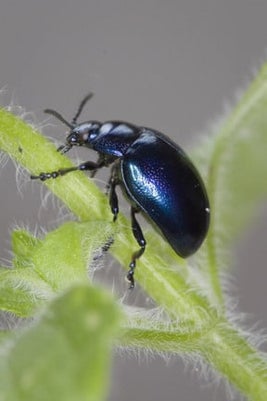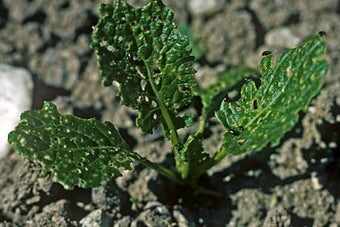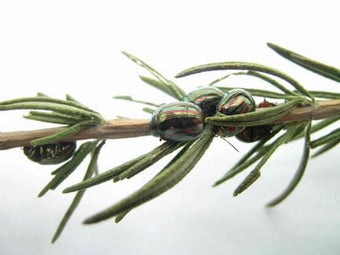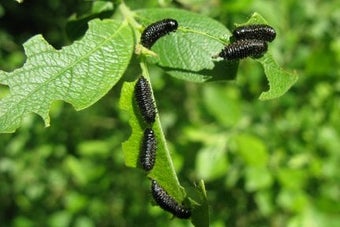
Quick facts
Common name - Blue mint beetle
Scientific name - Chrysolina coerulans
Plants affected - Mint (Mentha spp.)
Main symptoms - Holes in foliage, beetles on leaves
Most active - Spring to autumn
What does it look like?
- The adult beetle is 7 mm long and is a metallic dark blue
- The larvae reach about 1 cm in length, have soft rotund bodies that are blackish
- Both adults and larvae feed on the foliage of cultivated and wild mints, Mentha spp.
- It can easily be confused with alder leaf beetle and fuchsia flea beetle, blue mint beetle is only found on mint and is larger than the other two species

Are there other insects that eat mint leaves?
There is another beetle to Britain, known as the green mint beetle, Chrysolina herbacea. This is 8-9mm in length and is a shiny emerald green. The black larvae are similar to those of the blue mint beetle. Pale green caterpillars of several moths e.g. Pyrausta spp., are also found on mint; they loosely spin together foliage at the shoot tips with silk threads and eat the leaves. Some other species of moth caterpillar and slugs and snails also sometimes eat mint leaves.
Are there other dark blue beetles?
There are several other metallic blue beetles found in the UK. These include willow leaf beetles found on willows and poplars, the alder leaf beetle found on alder and less frequently other trees, and fuchsia flea beetle found on fuchsia, Zauschneria and wildflowers known as willowherbs, Epilobium spp. These other blue beetles are unlikely to be found on mint and are mostly less than 7 mm in length. The leaf beetle that occurs on alder is about 7 mm long. A rare blue form of the green mint beetle (see gallery above) sometimes occurs.
Blue mint beetle is a leaf beetle (family Chrysomelidae), there are about 250 species of leaf beetle found in Britain. Almost all feed on living plants, most are do not have a noticeable effect on garden plants. They range in size from size from 1 mm to 18 mm, many are colourful and many species are local or rare. More information on British leaf beetles can be found from UK Beetles.
Do I need to control blue mint beetle?
- Blue mint beetles are unlikely to be numerous enough to cause significant damage to healthy mint plants
- If necessary on small clumps of mint, it is feasible to remove the beetles and their larvae by hand














